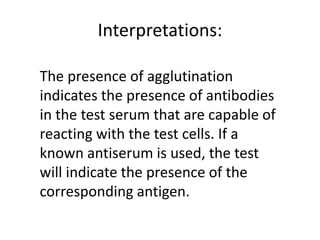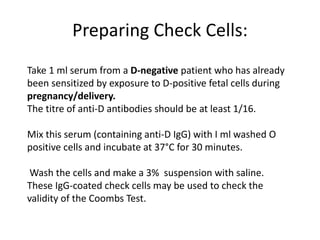coombs test
- 2. ANTIGLOBULIN TEST (COOMB‟S TEST) In some cases, a small antibody molecule such as IgG can sensitize red blood cells but cannot produce agglutination. The small size of the antibody‘s molecules makes them unable to overcome the forces that cause red blood cells to repel one another and hence fail to form cross-linked bridges that connect cells.
- 3. In 1945, Coomb et al described a test for detecting these non-agglutinating, coating (sensitising) antibodies. Later, the same test was used to demonstrate the coating of red blood cells with complement components as well. This test is known as the Antiglobulin Test or Coomb‘s Test. The antiglobulin test is performed in two ways: The Direct Antiglobulin Test (DAT) and indirect Antiglobulin Test (IAT).
- 4. THE DIRECT ANTIGLOBULIN TEST (DAT) The Direct Antiglobulin Test initiates the agglutination of human red blood cells that have already been sensitized in vivo by antibodies or complement components. Coomb‘s serum, containing both anti-human globulin and anticomplement antibodies, can detect both of these sensitized cells by inducing visible agglutination.
- 5. Indications It is indicated for the determination of antibody coated red cells in the haemolytic disease of newborns, auto-immune haemolytic anaemia and following haemolytic transfusion reactions
- 6. Procedure: 1. Wash the patient‘s red cells three times with normal saline. 2. Add a volume (drop) of 3% washed red cell suspension in a test tube. 3. Add 2 drops of Coomb‘s Reagent. 4. Mix and centrifuge for 15 seconds. 5. Re-mix the cells gently and observe for agglutination. 6. Confirm microscopically, for the presence of agglutinates or otherwise.
- 7. Interpretations: Agglutination indicates a positive test which means that the red cells have been sensitized in vivo either with an antibody alone or with complement components. A valid negative test indicates a lack of in vivo sensitization or insufficient globulin or complement molecules on the red cell surface to allow detection
- 8. INDIRECT ANTIGLOBULIN TEST The Indirect Coomb‘s Test is used to demonstrate circulating antibodies in the serum, which do not agglutinate cells suspended in saline. This depends on the combination in vitro of an antibody with its specific antigen. In the indirect test, normal O+ Group red cells are exposed to a serum suspected of containing an antibody and are subsequently tested after washing to see whether they have been sensitised or otherwise.
- 9. Two steps are required. The first step involves the incubation of the serum with known O Group red cells to allow them to become coated with the antibody (if it is present in the serum). The second step involves testing for sensitised cells as in a Direct Coomb‘s Test.
- 10. Indications: 1. Compatibility testing (cross match). 2. Detection and identification of irregular antibodies. 3. Detection of antibodies, e.g. Kell, Duffy and Kidd, etc. 4. Investigation of Immune Haemolytic Anaemias.
- 11. Procedure: 1. Two volumes (drops) of serum are placed in a test tube. 2. One volume (drop) of 3% red cell suspension is added to it. 3. Mix thoroughly & Incubate at 37°C for 50 minutes. 4. Wash these cells three times with normal saline. 5. After the removal of the saline of the last wash, add 2 drops of Coomb‘s Reagent. 6. Mix and centrifuge for 15 seconds. 7. Re-mix the cells gently and observe for agglutination. Confirm microscopically. 8. If the test is negative, add 1 drop of check cells to confirm the validity of the Coomb‘s serum. 9. Reduce the incubation time to 10 minutes if an equal volume of LISS is added to the patient‘s serum.
- 12. Interpretations: The presence of agglutination indicates the presence of antibodies in the test serum that are capable of reacting with the test cells. If a known antiserum is used, the test will indicate the presence of the corresponding antigen.
- 13. Quality Control: The antiglobulin serum should be checked against known, sensitized cells. The sensitized red cells may either be commercially purchased or prepared in the laboratory
- 14. Preparing Check Cells: Take 1 ml serum from a D-negative patient who has already been sensitized by exposure to D-positive fetal cells during pregnancy/delivery. The titre of anti-D antibodies should be at least 1/16. Mix this serum (containing anti-D IgG) with I ml washed O positive cells and incubate at 37°C for 30 minutes. Wash the cells and make a 3% suspension with saline. These IgG-coated check cells may be used to check the validity of the Coombs Test.
- 15. SOURCES OF ERROR IN ANTIGLOBULIN TESTS False „Negative‟ Tests: 1. The test tubes or pipettes may be dirty. 2. The red cells may have been inadequately washed. 3. Proteins on the fingertips may neutralise AHG and thus a false negative result may be obtained. 4. The incubation time was too short /too long. 5. The incubation was at a temperature that did not activate the antibody. 6. There was a delay in reading the test or in performing the test, thus allowing the antibody to be eluted off the red cells 7. The test cells were stored improperly, causing them to loose activity. 8. The antiglobulin serum is inactive (improper storage) or it was not added at all. 9. A change in the optimal ratio of antibody to antigen. 10. If plasma, rather than serum, was used. 11. Under-centrifugation
- 16. False „Positive‟ Tests 1. A presence of heavy metal ions can cause nonspecific agglutination. 2. Bacterial contamination of the test cells due to improper storage. 3. Refrigerated, clotted blood results in a nonspecific binding of C4, which can react with the anti-complement of the antiglobulin serum. 4. Over centrifugation will result in a false positive test
















